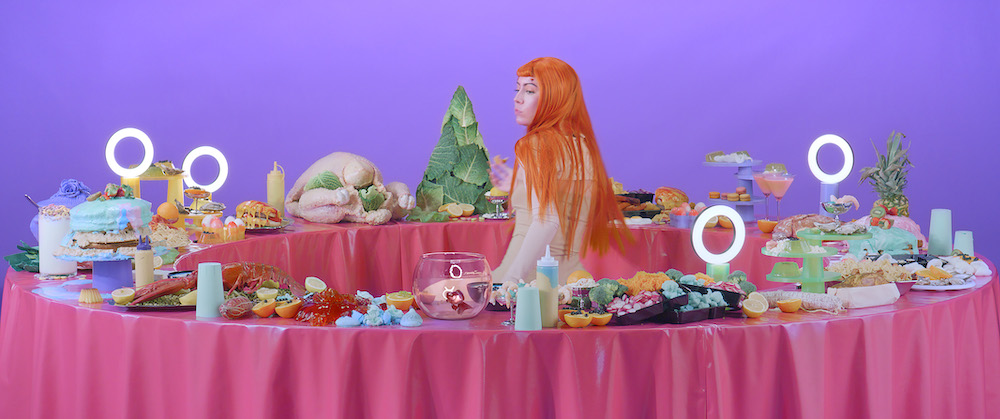Technology cannot be separated from the world we live in today. Indeed, post-pandemic, we are experiencing even more of our daily lives virtually. This phenomenon lies at the core of French multidisciplinary artist Ethel Lilienfeld’s work. Using video, installation and photography, Lilienfeld examines our relationships with technology and the virtual body—avatars we create to engage in digital realms. In recent years, she has considered self-image and the filters that augment—or completely change—our appearances.
“I am interested in exploring the codes of representing femininity throughout art history and examining how these codes have evolved in today’s digital age, especially on social media,” Lilienfeld, who was born in 1995, said in an email interview. “The relationship we have with our own
image has changed and is now continuously archived and updated online.”
As technology advances, social media has become a tool through which humans grapple with the self and the truth behind what we view and consume online. We are now capable of creating virtual bodies regardless of whether or not they reflect reality. “This way of perceiving ourselves, especially through filters, has given rise to new neuroses, such as Snapchat Dysmorphia, a pathology characterized by the compulsive desire to resemble one’s digitally filtered self,” she explained. “It leads some people to go to the surgeon with their ‘filtered’ double as a model.”
This past March, Lilienfeld presented her work for the first time in the US in the 2024 FotoFest Biennial, the storied Houston photography exhibition. The artist’s four-channel video installation INVISIBLE FILTER (2022), was a standout of the biennial, which centered on “Critical Geography” and considered the broader ways and spaces in which we live and engage with the world today. Lilienfeld’s presentation is accessible and impactful: Featuring two identical women of markedly different ages, the work highlights the tension between fiction and reality, as well as the norms and biases perpetuated through social media, particularly those of age and beauty.

EMI, 2023. Production: Le Fresnoy–Studio national des arts contemporains. Co-Production: La Fédération Wallonie-Bruxelles. Courtesy of the artist.
On one of the four screens in INVISIBLE FILTER, the two women appear in a sparse room. They move slowly in an unsettling way, pausing and kneeling next to a large basin. The younger woman cries into the tub and the older woman bathes her own face in the tears. A digital beep sounds as the tears hit the surface, joined by choppy gasps for air. On another screen, the older woman looks into the camera, her face covered by a youthful digital filter that smooths her skin, a stark contrast to her heavily wrinkled neck. A third screen shows a reflection of what appears to be the older woman in the basin of tears, recalling Narcissus becoming enamored with his own image. “It could also evoke the story of Dorian Gray,” Lilienfeld explained. Closer inspection reveals it is the reflection of the younger woman, who is presumably aging as her tears drain her of youth. On the final screen, which is on the back of the third, forcing the visitor to move around the installation to reveal the story, the viewer watches from outside the house and sees that the tear-filled basin acts as a youthful elixir for the older woman.
In creating this work, Lilienfeld was inspired by social-media personalities and influencer culture, including the popular Chinese vlogger, “Your Highness Qiao Biluo.” During a 2019 livestream, a glitch revealed that the youthful Qiao Biluo was in fact an older woman wearing a filter. She was
suspended from the streaming platform Douyu and the story of her downfall went viral, a “contemporary fable,” as Lilienfeld called it. The incident sparked conversations about the ethics of filters, beauty standards and if online personalities owe their audiences the truth about their identities.

“INVISIBLE FILTER,” 2022. Production: Le Fresnoy–Studio national des arts contemporains. Courtesy of the artist.
For her most recent project, EMI (2023), Lilienfeld addresses these themes directly. An interdisciplinary piece, EMI (an acronym for the French term for near-death experience) includes a film, website and NFTs. The project features a virtual influencer engaged in a frenetic advertisement-tutorial hybrid.
“Virtual influencers created from scratch have a story to tell, sharing their tastes, passions and vision with their community through a transmedia narrative,” Lilienfeld said. “They promise to stay eternally young and fashionable, and never have reputation problems.”
Produced with Le Fresnoy—Studio national des arts contemporains and co-produced with La Fédération Wallonie-Bruxelles, the project combines artificial intelligence, real footage and computer-generated images, demonstrating how advances in technology blur reality and fiction. The influencer overindulges on opulent food, drinks off-putting health supplements and uses beauty tools that pull on her skin, revealing glitchy eyes. “Behind its seductive form, EMI explores the increasing capitalization of the body online, inviting us somewhere on the edge of the beautiful and the repulsive, the real and the fictitious, the living and the dead,” Lilienfeld said.
For the NFT component, collectors become stewards of the influencer’s organs, a metaphor for the sense of ownership that people have about public figures and online personas. The organs come with a description similar to that of an autopsy report. As twisted as this might seem, it’s not unlike wearing another face through a digital filter—an act we’ve normalized on social media. Indeed, while Lilienfeld’s work is intentionally dystopian, it’s hard not to wonder if it’s that far removed from reality after all.


